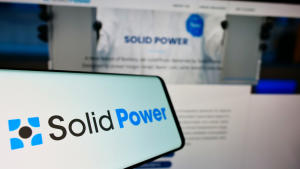3 Battery Stocks to Buy Now OR Regret Later
Despite being an unimpressive year for battery stocks, positive industry tailwinds for electric vehicle stocks and their energy sources will last well beyond this decade. Therefore, the correction in battery stocks makes now a good time to consider fresh exposure, especially since several developments are presently happening in the battery space.
The most anticipated is the possible commercialization of the solid-state battery by 2025 or 2026, as we will explore in the first example. This conventional battery maker is trading at an attractive valuation. Then, we can focus on two stocks that represent companies working towards the commercialization of solid-state batteries. If successful, these stocks can be massive wealth creators, despite the high risk and limited time exposure.
Let’s discuss the reasons to be bullish on these battery stocks.
Panasonic Holdings (PCRFY)

Panasonic Holdings (OTCMKTS:PCRFY) is the top name among battery stocks to buy. The blue-chip battery stock is undervalued, trading at a forward price-earnings ratio of 7.9. Further, PCRFY stock offers a dividend yield of 1.1%. Considering the valuations, the stock could likely double in the next 24 months.
In addition, Panasonic has set an aggressive growth target. The company plans to increase battery capacity to 200GWh by 2031. Compared to the last financial year, this would imply that the capacity quadruples. This will translate into healthy revenue and cash flow growth. Further, Panasonic will be positioned to maintain or potentially increase its market share.
Also, the company’s market share growth is highly likely since Panasonic is an innovator. As an example, the company has 445 patents in the solid-state battery space. Further, PCRFY claims to have developed a way to slow battery degradation and is targeting a 20% increase in battery density by 2030.
Solid Power (SLDP)

Solid Power (NASDAQ:SLDP) stock might have disappointed in the last 12 months. However, the company remains a top pick from the solid-state battery segment.
Even with steady business development, commercialization of solid-state batteries is likely in 2025 or 2026. Investors could expect positive price action after a deep correction with an impending catalyst.
Solid power is targeting to deliver EV cells to automotive partners for validation testing before the end of 2023. The company’s automotive partners include Ford (NYSE:F) and BMW (OTCMKTS:BMWYY). If results are encouraging from the validation testing, SLDP stock is likely to go ballistic from oversold levels.
Further, BMW is strongly backing the company, conducting parallel research and development. This can possibly help in accelerating the commercialization timeline. And as of Q2 2023, Solid Power has conserved cash, reporting a cash buffer of $443 million. This will probably support R&D over the next 24 months. Therefore, equity dilution seems unlikely in the foreseeable future.
QuantumScape Corporation (QS)

Also, QuantumScape (NYSE:QS) is a risk bet with the company pursuing potential commercialization of solid-state batteries. If successful, QS stock can deliver multibagger returns. Consider some exposure to the stock after a meaningful correction in the last 12 months.
QuantumScape claims to have 12 years of research and development investments related to the solid-state battery space.
Further, the company already has six commercial agreements with automotive original equipment manufacturers. This includes a strong partnership with Volkswagen (OTCMKTS:VWAGY). Notably, Volkswagen has publicly validated the performance of the company’s QS cells.
In terms of business development, QuantumScape is looking at higher cathode capacity and manufacturing scale-up in 2023. In the next year, the company is targeting low-volume B samples that will be followed by high-volume B samples. With positive business developments, QS stock could likely trend higher from oversold levels.
On the date of publication, Faisal Humayun did not hold (either directly or indirectly) any positions in the securities mentioned in this article. The opinions expressed in this article are those of the writer, subject to the InvestorPlace.com Publishing Guidelines.

